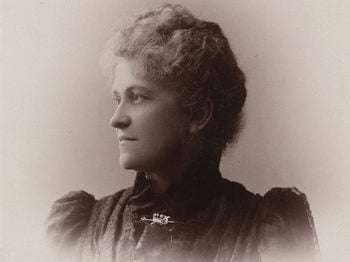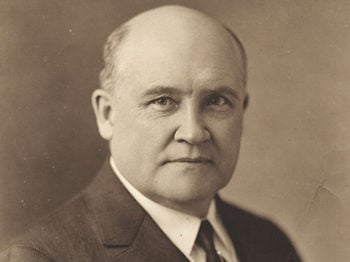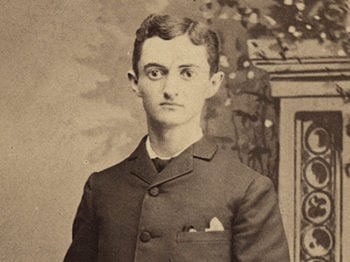
Jennie Logan Bryan was a practitioner and teacher of Christian Science in Peoria, Illinois for over fifty years. Her persistence in seeking out Christian Science as taught by Mary Baker Eddy took her from severe illness and hopeless drug dependence to complete freedom and the desire and ability to help others through Christian Science.
Miss Bryan was born in Peoria in 1859 , the youngest of six children. Her father, William Frederick Bryan, was a successful lawyer in central Illinois at the same time Abraham Lincoln was practising law in the area. Mr. Bryan and his wife, Jane Grubb Evans, were among Peoria’s early settlers, having moved there from Lancaster, Pennsylvania.
The Bryans, of Scotch-Irish descent, had been Presbyterians for generations. When Jennie was about fifteen years old, her parents left the Presbyterian church to join the Reformed Episcopal church. She, however, chose to stay with the old church, even though she knew little about the church doctrine. Miss Bryan later wrote in her memoirs that “during revival meetings I was led to believe that I was a terrible sinner because I had not been converted and joined the church. This was a very sad experience to me. I did not know how to be converted. I could not experience a change of heart, and I was so frightened that I became very ill. I feared that I might die before I could be taken into the church, and saved from hell.”1
The church elders made an exception in her case since she had always tried to live a Christian life, and they made her a member of the church.
Jennie was educated in public schools until her illness during high school, when she was tutored at home by her father. At seventeen she was sent to the Moravian seminary in Bethlehem, Pennsylvania, from which she graduated. Her eyes were so troublesome at this point that a college education was out of the question. She helped her mother around the home and was busy with church and club activities.
Painful eyes, a weak back, and various other physical disorders kept Miss Bryan miserable much of the time. At age twenty-four she became seriously ill. She received homeopathic treatment until her parents reluctantly called in the “old school of medicine.” A severe form of spinal disease was diagnosed, with no possibility of recovery. At the time, Miss Bryan believed that God would heal her when she had suffered sufficiently for her sins. She later wrote, “I could not imagine what awful sin or sins I had committed to merit such severe punishment, but had a childlike trust in God, and His justice.”2
A year of excessive drugging convinced Miss Bryan that medicine could not heal her. She found comfort in Bible passages which promised God’s unfailing help , guidance and protection.3 The druggist who had been filling the prescriptions for the various opiates that were being administered to her, finally told the Bryan family that Miss Bryan was being drugged to death and he could not understand how she had lived so long.
In this desperate state, with her death expected daily, Miss Bryan was introduced to Christian Science healing. A friend of hers had visited a Christian Scientist while in Boston and recommended this new method of healing through prayer. Ten days of absent treatment enabled Miss Bryan to overcome her dependence on the drugs. However, those around her insisted on a return to medical treatment.
A new doctor in town was consulted. As Miss Bryan later remembered, “He called his method ‘Electro-Homeopathy.’ He used hypnotism, also did some rubbing, and gave some exceedingly high potency medicine, explaining the virtue of the latter in a very learned way at first, but later he frankly said that it was hypnotism that he was depending upon altogether in my case, as I was way, way beyond the power of medicine.”4
After a year of such treatment, a type of “mind-cure” which was falsely being called Christian Science was brought to Miss Bryan’s attention.5 Her doctor recommended that she try it, but cautioned her that even if she was healed of the incurable spinal disease , nothing could reverse the effects of the long-time drug use. A woman who had come to Peoria espousing the “mind-cure” method came to see Miss Bryan. After a week of treatment through prayer, she was greatly improved and was able to continue treating herself when the woman moved on to another city.
Miss Bryan and her mother had been told by this “mind-cure” woman that Mary Baker Eddy was the Discoverer of Christian Science and the author of its textbook, Science and Health with Key to the Scriptures. This they sent for immediately. But she also recommended to them, as beginners, a book that she had written herself, which she said contained the same truth as Science and Health but was easier to understand. In reading this book and other literature of the same kind, Miss Bryan found that she could not remember anything she had read. She did not like what she heard at lectures on “mental science,” also falsely being called Christian Science at that time. When she finally became alert to the fact that Science and Health was the only true textbook of Christian Science, and the only book she wanted to read on the subject, she burned all the illicit literature she had. She found she had no trouble understanding Science and Health, and her complete healing began. Also, she no longer suffered with her eyes or needed to wear glasses.
Feeling that she had finally found her life work, Miss Bryan began right away using her understanding of Christian Science to heal others. She and her mother separated themselves from the “mind-curists” in town. Miss Bryan longed for correct teaching and hoped to be taught one day by Mrs. Eddy herself.
In the 1880’s, several individuals and groups appropriated the name but had perverted the teachings of Christian Science.6 Miss Bryan applied for instruction at the “Emma Hopkins College of Christian Science” in Chicago, but decided not to go. Then some Christian Scientists who had just had Normal class with Mrs. Eddy arrived in Peoria, prepared to teach a class. After talking with them, Miss Bryan concluded that in order to get the pure and true teaching, she would have to go directly to Mary Baker Eddy.
In September 1888, just three years after she had first heard of Christian Science, Jennie Logan Bryan went to Boston to have Primary class instruction from Mrs. Eddy.7 She later described her teacher as follows: “She was gentle, and loving, so kind and considerate of the timid ones like myself; so marvellously patient, yet so firm, even stern at times, and her rebuke of error was severe …. Then another thing that made an impression upon me was her vein of humor.”8
In an interview after the class, Miss Bryan sought Mrs. Eddy’s counsel on how to deal with the “mind-curists” calling themselves Christian Scientists in her city. She returned to Peoria determined to be faithful to the teaching she had received in class. Miss Bryan went through a very trying period and considered relocating in another city. But she saw that her duty was to lift the banner of true Christian Science above what was then masquerading as Christian Science in Peoria. She announced that meetings would be held, and “those who wished to study Christian Science as taught by Mrs. Eddy, and who intended to use the Bible and Science and Health as their only textbooks were welcome to attend, — but only those.”9 The Cause of Christian Science grew steadily there from that time.
When Christian Science Sunday services were begun in Peoria in 1890, Miss Bryan parted amicably from her Presbyterian pastor, Dr. Thomas X. Orr, and sought a letter of dismissal from her old church. She never received one, the church officials having decided that those who withdrew to join the Christian Scientists did not deserve a letter of dismissal.
Miss Bryan served her branch church as director, speaker and First Reader. She was first listed in The Christian Science Journal as a practitioner in August 1890. When the By-Law “Church Organizations Ample” was added by Mrs. Eddy to the Church Manual in 1904, Miss Bryan withdrew from the Daughters of the American Revolution because her church work and busy practice took up all of her time.10 She began teaching Christian Science in 1899, and she had further Christian Science instruction with Dr. Alfred Baker. In succeeding years she made frequent trips to Boston to consult with The Christian Science Board of Directors regarding the progress of Christian Science in her field.
In 1919 Miss Bryan’s portrait was painted by Boston artist Chase Emerson, to be added to Mary B. Longyear’s collection of portraits of early Christian Scientists. Today this painting may be seen along with the many others at the Mary Baker Eddy Museum. These portraits line the Museum’s halls and galleries, testimonies on canvas to the unselfish work of these pioneers and their fidelity to the truth as taught by Mary Baker Eddy.









